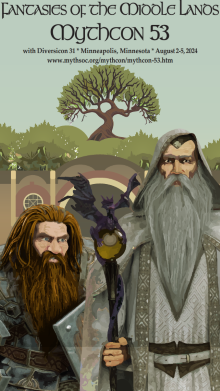Home > MYTHSOC > Mythlore > Vol. 41 (2022) > No. 2 (2022)
Abstract
Abstract
Between 1987 and 2015, Terry Pratchett published eleven novels and one short story within his Discworld universe that came to be known as his “Witches” sub-series. In these texts he engaged with the narrative imperatives, preoccupations, and tropes which together make up the consensus fantasy universe, and those deeper mythologies and legendarium with which the author necessarily has an intertextual relationship. This paper focuses upon one aspect of that consensus universe, which is the difference between male and female magical practitioners—witches and wizards—in the fantasy canon, and how Pratchett sought to challenge and subvert the stereotypes of the genre in his own work. The primary means by which Pratchett achieved this, I have argued, is by exposing the fictionality of these stereotypes through parody and satire, whilst at the same time embedding these same tropes within his own universe as the building blocks of his secondary world.
The period during which the “Witches” novels were produced is roughly commensurate with a timeframe in which the range of academic and activist positions which are broadly regarded as constituting second-wave feminism were giving rise to, being overtaken by (or in some cases were in direct conflict with) a multiplicity of newer scholarly approaches which have been described as comprising a third wave. Whilst it would be wrong-footed to attempt to position Pratchett’s ‘Witches” novels as a direct engagement with any of these theories, we can see in his writing an awareness of the shifting landscape of feminist thought, with themes in the earliest novels that take up ideas of equality of access similar to those that dominated first-wave discourse, as well as a growing cast of characters and range of thematic concerns that come to reflect the divergence of second and third-wave debates about biological sex and gender identity.
Although Pratchett’s work does not itself constitute feminist scholarship, I have argued that through his engagement with some of the evolving ideas about women and their relative position in society, his “Witches” novels can be read as an attempt to change the way that women are portrayed in fantasy literature by intersecting with ideas that are external to it. In this respect, and by interpreting his work in terms of de Beauvoir’s archetypal stereotypes and her theory of Other, as well as Grosz’s work on feminine corporeality and Butler’s ideas of gender performativity, I have sought to illuminate how Pratchett’s fiction not only sits within a wider body of feminist discourse but can also bear the weight of such critical analysis.
Creative Commons License

This work is licensed under a Creative Commons Attribution-NonCommercial-No Derivative Works 4.0 International License.
ORCID ID
0000-0002-1813-4651
Copyright held by Artist
Included in
Children's and Young Adult Literature Commons, Literature in English, British Isles Commons


